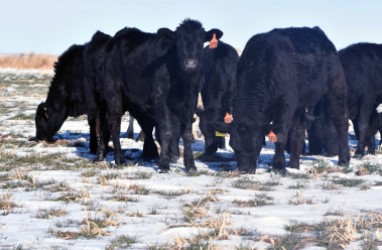A set of calves grazing winter pasture at the New Mexico State University Clayton Livestock Research Center near Clayton, New Mexico, may look typical of Texas High Plains cattle, but this group is special – they are Raramuri Criollo crossbred calves.

Criollo-cross calves carry the black Angus attributes.
And, the improved pasture they are grazing is planted with a
Texas A&M AgriLife Research wheat-breeding program variety in an effort to closely mirror the beef production systems of the Texas High Plains.
Raramuri Criollo are a biotype of Criollo cattle, originally brought to the Americas by the Spanish conquistadors and currently raised by the Tarahumara people of Copper Canyon in Chihuahua, Mexico.
Criollo cattle are related to the Texas longhorn and known to use semi-arid rangelands more fully or efficiently, said Glenn Duff, Ph.D., superintendent at the Clayton Livestock Research Center and a co-investigator on the project. Criollo cattle have a tendency to travel further on the range than Angus or Brangus cattle. The breed’s cows are also well known for easy calving, which is critically important in the expansive, remote, desert rangelands of the Southwest.
“What we are trying to determine in this project is if the hybrids of these animals – Criollo and Angus or Brangus – mirror how fully the pure Criollo use the rangeland,” Auvermann said.
Criollo cattle in the New Mexico State University Clayton Livestock Research Center pens near Clayton, New Mexico.
Criollo-cross calves find new homes
The research project will include three rotations of calves from Criollo cows crossed with red and black Angus and Brangus bulls that are brought to this region from three different ranches in California, Nevada and Utah, Auvermann said. There are 120 calves in each rotation, with 40 from each ranch. Half are steers, and half are heifers.
This first set of calves will spend about four months on wheat, due to some timing issues with the COVID-19 precautions this year. However, the plan is for each set to arrive in October and spend six months on wheat pasture and then in the feedlot for about six months, which is typical of current cattle production systems.
Of particular interest to AgriLife Research is how the calves perform on the pasture planted to TAM 204 wheat, developed by Jackie Rudd, Ph.D., AgriLife Research wheat breeder, Amarillo. TAM 204 is an increasingly widely adopted dual-purpose wheat variety developed specifically for the Rolling Plains.
Irrigated TAM 204 wheat is a part of the Criollo-cross research program.
Rudd said the TAM 204 is an awnless hard red winter wheat developed for grazing, but in addition to high forage yields it also has a great grain yield throughout Texas. The parentage of TAM 204 includes the popular drought-tolerant TAM 112 and Jagger, which was well known for excellent fall grazing.
Following their time on wheat, half of the calves in each cycle will be shipped to AgriLife Research’s feedlot facility near Bushland to finish on a standard, high-concentrate diet characteristic of commercial cattle feed yards in the High Plains, while the other half will be fed at the Clayton Livestock center.
A Criollo-black Angus cross calf.
All the animals will then go to the Tyson plant in Amarillo, where the Beef Carcass Research Center at West Texas A&M University led by Ty Lawrence, Ph.D., will score the carcasses and collect steak samples. The steak samples will be sent to Texas A&M’s
College of Agriculture and Life Sciences Sensory Science Evaluation Laboratory directed by Rhonda Miller, Ph.D., meat science professor in the
Department of Animal Science in Bryan-College Station, for taste and tenderness testing.
Ultimate goal
This five-year project will analyze the Criollo crossing effects on profitability, efficiency, ecosystem, feed yard performance, and carcass and meat quality.
“In these crossed calves, if there is any adverse effect on the ultimate carcass quality and palatability, to a great extent that will determine the marketability of this kind of animal,” Auvermann said.
Duff said so far, these cross calves look very much like an Angus – no Criollo horns and with a “gorgeous” Angus frame. And the same appears to be true of the Brangus crossed with Criollo.
Ultimately, the grazing performance of the Criollo cattle, plus the Brangus and Angus crossing made for meat quality and carcass yield, is expected to improve the animals’ prospects for adoption in cattle-feeding production chains of this region, Auvermann said.
Source : tamu.edu